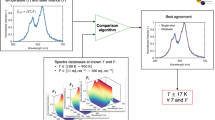Abstract
In this study, a correction method based on background subtraction to remove thermal radiation from luminescent signal was proposed for intensity-based thermometry using thermographic phosphors. Mg4FGeO6:Mn was used as sensor material for a temperature range from 490 to 590 °C. A UV LED was used as excitation source and a spectrometer was used to collect the spectrum of both luminescence and thermal radiation for analysis. Then a CCD camera was used to conduct phosphor thermometry, including calibration and a jet impingement experiment. The calibration results showed that the measurement without correction would fail above 540 °C due to thermal radiation, whereas the correction method could effectively remove the effect of thermal radiation and extend the temperature range up to at least 590 °C. The use of band-pass filter around emission wavelength could reduce the effect of thermal radiation, but correction is still required for the case of higher temperature or lower excitation light. This correction method was then demonstrated in both steady and transient temperature measurements of a jet impingement experiment.
Graphical abstract










Similar content being viewed by others
References
Alden M, Omrane A, Richter M, Sarner G (2011) Thermographic phosphors for thermometry: a survey of combustion applications. Prog Energ Combust 37:422–461
Allison SW, Gillies GT (1997) Remote thermometry with thermographic phosphors: instrumentation and applications. Rev Sci Instr 67:2615–2650
Born M, Wolf E (1999) Principles of optics, 7th edn. Cambridge University Press, Cambridge
Brübach J, Pflitsch C, Dreizler A, Atakan B (2013) On surface temperature measurements with thermographic phosphors: a review. Prog Energ Combust 39:37–60
Bugos AR (1989) Characterization of the emission properties of thermographic phosphors for use in high temperature sensing application. M.S. Thesis, University of Tennessee
Bugos AR, Allison SW, Beshears DL, Cates MR (1988) Emission properties of phosphors for high temperature sensor applications. In: Proceedings of the IEEE southeastcon conference IEEE, pp 228–233
Cates MR, Allison SW, Jaiswal SL (2003) YAG: Dy and YAG: Tm fluorescence above 1400°C. Department of Energy, United States
Chambers MD, Clarke DR (2009) Doped oxides for high-temperature luminescence and lifetime thermometry. Annu Rev Mater Res 39:325–359
Imanaga S, Yokono S, Hoshima T (1980) Luminescence saturation effects in Y2O2S:Eu. Jpn J Appl Phys 19(1):41–49
Khalid AH, Kontis K (2008) Thermographic phosphors for high temperature measurements: principles, current state of the art and recent applications. Sensors 8(9):5673–5744
Khalid AH, Kontis K (2011) Quantum efficiencies, absolute intensities and signal-to-blackbody ratios of high-temperature laser-induced thermographic phosphors. Luminescence 26(6):640–649
Ranson RM (1999) Investigation into thermographic phosphors. Disseration, Nottingham Trent University, Ph.D
Yi SJ, Kim KC (2014) Luminescence-based multiphysics visualization: a review. J Visual-Japan. 17:253–273
Yi SJ, Kim HD, Kim KC (2014) Decay-slope method for 2-dimensional temperature field measurement using thermographic phosphors. Exp Therm Fluid Sci 59:1–8
Acknowledgments
The authors gratefully acknowledge financial support for this study from the National Natural Science Foundation of China (Grant Nos. 51176108 and 11372189).
Author information
Authors and Affiliations
Corresponding author
Rights and permissions
About this article
Cite this article
Cai, T., Peng, D., Liu, Y.Z. et al. A correction method of thermal radiation errors for high-temperature measurement using thermographic phosphors. J Vis 19, 383–392 (2016). https://doi.org/10.1007/s12650-015-0332-8
Received:
Revised:
Accepted:
Published:
Issue Date:
DOI: https://doi.org/10.1007/s12650-015-0332-8




